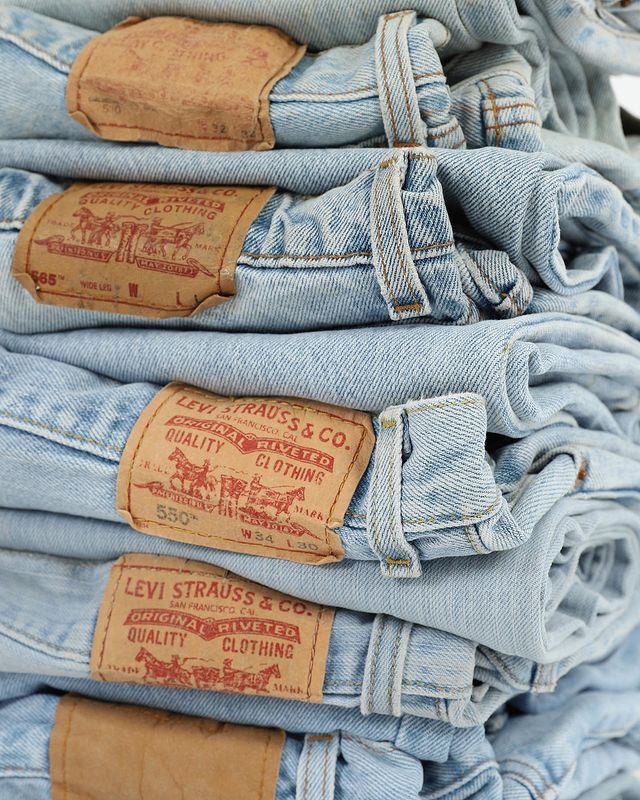


Looking to invest in a pair of vintage Levi's Jeans? A classic wardrobe staple, timeless, they will last and last, it's more likely your body shape will change before they are showing any signs of wear.
What is it about Levi's that makes us love them so much?
For us, it's the fit, the wrap around shape and pocket placement that makes our bum look peachy! There's nothing better than finding the perfect fit, worn in just the right areas, our year round wardrobe staple item.
Built to last, the majority of Levi's are 100% cotton, the quality of the stitching and craftmanship means that even 20 years old they still look great and last longer than alternatives found on the high street.
What to look for when shopping for your perfect pair, to make sure you are buying original and not fakes
THE COLOURED TAB

The famous red label, a sign of quality, known worldwide. Considered the trademark of an original 501 was added to all 501 jeans in 1936. Later Levi's added this trademark to it's denim jackets.
Levi's red table with a lowercase "e" was changed in the 1970's so if you find a Levi's with a capital E you know you have a truly vintage pair pre 1970's.
Got a pair with a blank red tabs, are these fake? In a word no, to extend their trademark capabilities Levi's introduced the blank red tab with only ® as the red tab was getting imitated and Levi's wanted to protect their world renouned label and trademark.
Levi's introduced the orange tab in the 1960's with a more fashion led designs such as flares and boot cuts.
The silver tab was introduced in 1988 to reflect its grunge denim, a baggy fit.
CARE TAGS AND HOW TO READ THEM
Care tags were added into all Levi's from 1970's. What does yours look like and what year was it manufactured?
- A protype care tag prior to 1967
- small white care tag 1967-1984
- large white care tag 1983-1986
- red batwing 1987-1995
- black batwing 1991-2003
- red thick batwing 1995-2002

HOW TO READ THE NUMBERS ON THE BACK OF THE CARE TAG
It's easy to get confused with the large amount of numbers found on the back of the white wash and care label. Where to start?
Firstly, lets break them down into groups.
The first number is the product code ie 501. The Product Code can be found in two places. The first is on the garment. You can see it on the small, white 'wash & care' labels sewn into each of our products. This version of the code should start with 'PC9', followed by 5 numbers, a dash, then 4 more numbers. The product Style is identified by the first 5 digits, for example: 00505 = Men’s 505 jeans. The product Finish is identified by the last 4 digits, for example: 00505-4886 = Men’s 505 jeans in Dark Stonewash. You can search these codes on Levi's website, referring to them as a PC code,search with all 9 digits no spaces to check your model.
The denim or wash code comes next, a 0217 code means that it has been preshrunk. Originally the denim was not prewashed, customers would wear their new Levi's and sit in the bath to get the perfect fit!
Next, you will find the factory code, this can be 1,2 or 3 digits. You can also cross check these codes, there is also one on the rear side of the top button on the fly.
Most important numbers on the back is the date code, and these come in 2, 3 or 4 digits. Specfically the month and the year. But how to know the difference for the year if only one number.
In 1993 Levi's introduced 4 digit code, month ie 12 and then the year ie 95.

Here's a great youtube video that explains in more detail
https://www.youtube.com/watch?v=cZd0rYBApRA
LOOK AT THE SELVEDGE
What is selvedge? Selvedge is a weaving method that manufacturers used during the mid-to-late 1900’s. But… what are the differences at first glance?

If your jeans look like this, they’re probably from before the 1980’s. The selvedge production used to slow the manufacture, that’s why they decided to switch to the well-know “non-selvedge weave”.

The inseam on Levi's made before mid 1980's showcase only a single stitch on the inner thigh.
POCKET STITCHING ACUATE
Besides creating a peachy-looking bum, the pockets will tell you a lot about the age of your Levis. Originally the V shaped arcuate was made using a “single stitch” which showed the skill of the operator and could vary slightly between each pair.

During World War II, these were omitted and painted on instead, to save thread for the war effort. By 1947, double stitch machines had been introduced and this created the central diamond visible today.

RIVETS
These metal studs can be also know as the Levi’s ID. If the back plates of the rivets are silver coloured the jeans are post-1960’s. But if the back plates are copper ones and the letters aren’t lowered you are holding a pair of pre-1960’s jeans!


FRONT BUTTON
Finally check the front button and check it's branded with the Levi Strauss & Co.





